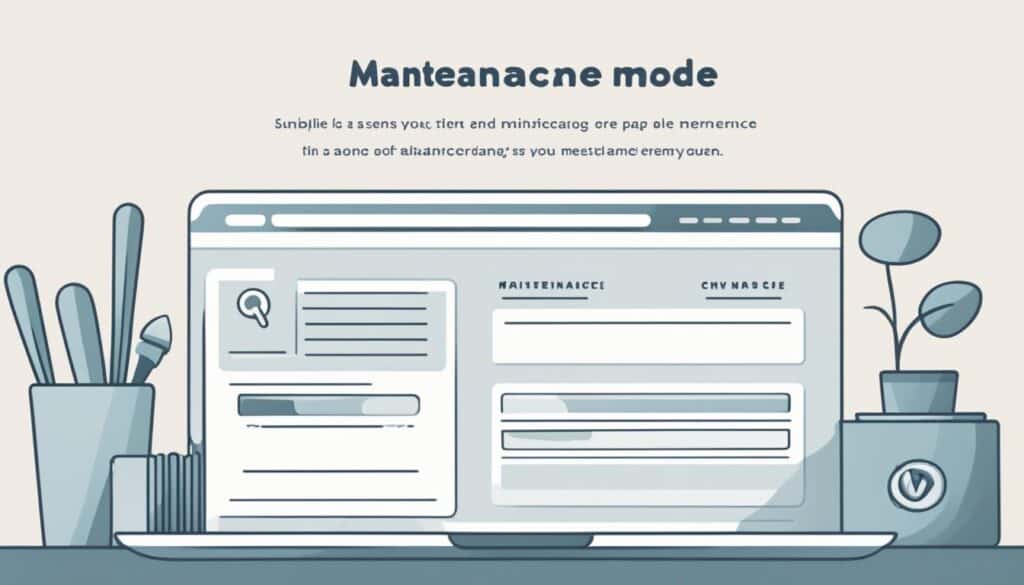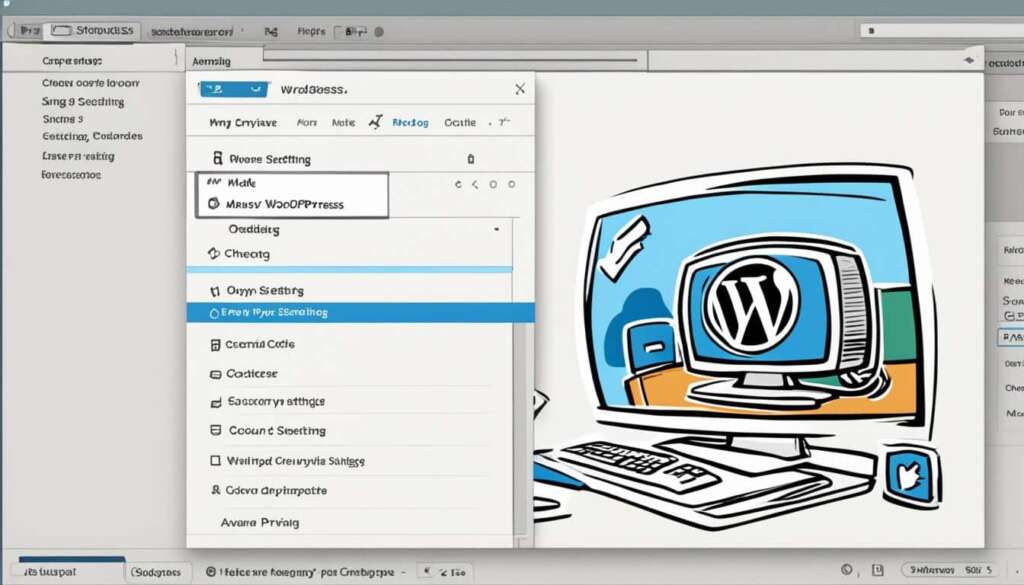Table of Contents
In this comprehensive guide, we will walk you through the process of unpublishing your WordPress website. Whether you’re temporarily taking your site offline for maintenance or permanently shutting it down, this step-by-step tutorial will help you navigate the necessary actions to ensure a smooth transition.
When it comes to managing your WordPress site, there may be various reasons why you need to take your website offline. It could be for routine maintenance, updates, or even a complete shutdown. Regardless of the circumstances, it’s essential to know how to unpublish your WordPress site in a structured and discreet manner.
In this guide, you’ll gain a clear understanding of the implications of unpublishing and discover how to back up your site before proceeding. We’ll guide you through the process of setting up a maintenance mode page to provide your visitors with a user-friendly message during the downtime. Additionally, we’ll ensure that search engines don’t index your unpublished site to maintain privacy. Lastly, we’ll cover the steps needed to remove your WordPress site from public view, be it through redirecting visitors or displaying an offline message.
Key Takeaways
- Unpublishing your WordPress site is a strategic process requiring careful consideration.
- Before unpublishing, back up your WordPress site to prevent any data loss.
- A maintenance mode page is essential for site downtime, providing visitors with a user-friendly message.
- Prevent search engines from indexing your unpublished site to maintain privacy.
- Remove your WordPress site from public view using appropriate redirection or offline messages.
Understanding the Implications of Unpublishing
Before delving into the technical steps of unpublishing your WordPress site, it’s crucial to understand the implications of this action. Whether you’re temporarily taking your site offline or permanently shutting it down, unpublishing can have significant effects on your website’s visibility and search engine ranking.
When it comes to unpublishing, there are two main scenarios to consider: temporary and permanent. Let’s explore both:
Temporary Unpublishing
If you’re planning to temporarily unpublish your WordPress site for maintenance or updates, it’s important to understand the implications. During this period, your website will be unavailable to visitors, but it will still exist in the background.
This can have the following implications:
- Website Visibility: While your site is unpublishing, it will not be visible to users who try to access it directly or through search engines.
- Search Engine Ranking: Temporarily unpublishing your site may have a negative impact on your search engine ranking. Search engines value consistent and accessible content, so when your site is unavailable, it may drop in the rankings.
To mitigate these effects, consider setting up a maintenance mode page, which we’ll discuss in detail in section 4.
Permanent Unpublishing
If you’re permanently unpublishing your WordPress site, it means you’re shutting it down indefinitely. This action can have long-lasting effects on your online presence.
This can have the following implications:
- Website Visibility: Once your site is permanently unpublished, it will no longer be accessible to anyone. Your site’s URL may become inactive, and users won’t be able to find your content.
- Search Engine Ranking: Permanent unpublishing can significantly impact your search engine ranking. Search engines prioritize active and regularly updated websites, so when your site is no longer available, it may lose visibility and ranking.
It’s important to carefully consider the implications of permanent unpublishing before making this decision. If you’re unsure about the future of your site, you may want to explore alternative options, such as redirecting your domain or displaying an offline message.
In the next section, we’ll discuss the steps to back up your WordPress website, ensuring that your valuable data is protected during and after the unpublishing process.
Backing Up Your WordPress Website
Prior to unpublishing your WordPress site, it’s essential to create a backup to protect your valuable website files and database.
Backing up your WordPress site not only safeguards your data, but it also ensures that you can easily restore your website in the event of any unforeseen issues or data loss. By following these simple steps, you can prevent data loss and have peace of mind during the unpublishing process:
- Plugins: Install a reliable backup plugin like UpdraftPlus or BackupBuddy to simplify the backup process.
- Choose a Backup Location: Select a secure storage option such as your computer, external hard drive, or cloud storage service to store your backup files.
- Configure Backup Settings: Customize the backup settings according to your preferences, including the frequency of backups and the specific files and database tables you want to include.
- Initiate the Backup: Click on the backup button to start the backup process. Depending on the size of your website, it may take a few minutes to complete.
- Verify the Backup: Once the backup is complete, verify its integrity by downloading a copy and ensuring that all the files and database tables are included.
Remember to regularly update and test your backup plugins to ensure that they are compatible with the latest version of WordPress.
Importance of Regular Backups
“Backing up your WordPress site is like having an insurance policy for your valuable website data. It gives you peace of mind knowing that you can quickly recover your site in case of any mishaps or data loss.”
By regularly backing up your site, you minimize the risks associated with potential data loss and protect your hard work. Whether it’s accidental deletions, security breaches, or problems during the unpublishing process, a backup copy ensures that you have a reliable restore point to bring your website back online effortlessly.
Having a reliable backup strategy in place is crucial for any website owner. It provides an additional layer of protection and helps you maintain control over your website’s valuable files and database.
Next, we’ll guide you through setting up a maintenance mode page to keep your visitors informed while you work behind the scenes.
Setting up a Maintenance Mode Page
When it comes to temporarily taking your WordPress site offline for maintenance or updates, creating a maintenance mode page is essential. This page, often referred to as an “under construction” or “temporary closure” page, allows you to display a user-friendly message to your visitors while you work on your site behind the scenes.
So how can you create an eye-catching maintenance mode page that effectively communicates your temporary closure to your audience? Here are some key steps to follow:
1. Choose a Maintenance Mode Plugin
First, you’ll need to select a suitable maintenance mode plugin. WordPress offers various plugins that allow you to set up a visually appealing and user-friendly page. Some popular options include:
- Coming Soon Page & Maintenance Mode by SeedProd
- WP Maintenance Mode by Designmodo
- Under Construction by WebFactory Ltd
These plugins provide pre-designed templates and customizable options to help you create a stunning maintenance mode page that aligns with your website’s branding.
2. Customize Your Maintenance Page
Once you’ve chosen a plugin, it’s time to customize your maintenance page. This involves selecting a theme or template, adjusting the layout, and adding relevant content.
Consider including the following elements:
- An eye-catching headline or title indicating that your site is currently under maintenance
- A brief message explaining the reason for the temporary closure
- An estimated timeframe for when the site will be back online
- Contact information or social media links to stay connected with your audience
Remember to keep your message clear, concise, and professional. Also, consider adding a visually appealing image or background that complements your brand.
3. Enable User-Friendly Features
Make your maintenance mode page user-friendly by including features that enhance user experience. This may include:
- A subscription form to collect emails and notify users when your site is back online
- Links to important pages or resources that visitors may need access to
- Social media buttons for easy sharing and engagement
By incorporating these features, you can maintain engagement with your audience and keep them informed during the temporary closure.

| Plugin | Key Features |
|---|---|
| Coming Soon Page & Maintenance Mode by SeedProd | Drag and drop page builder, custom CSS and HTML support, integrated contact forms |
| WP Maintenance Mode by Designmodo | Customizable templates, countdown timer, email notifications |
| Under Construction by WebFactory Ltd | Responsive design, progress bar, social media integration |
By following these steps, you can create an attractive and informative maintenance mode page that effectively communicates your temporary site closure to your visitors. Remember, a well-designed and user-friendly page will help maintain a positive user experience even during periods of maintenance or updates.
Disabling Search Engine Indexing
When unpublishing your WordPress site, it’s important to take steps to prevent search engines from indexing its pages and content. This ensures that your unpublished site remains hidden from search engine crawlers and maintains its privacy. To achieve this, you can utilize the robots.txt file and add the appropriate noindex tag to your webpages.
Using the Robots.txt File
The robots.txt file is a protocol that tells search engine crawlers which pages and content they are allowed to access on your website. By properly configuring this file, you can prevent search engines from indexing your site during the unpublishing process. To utilize the robots.txt file, follow these steps:
- Create a text file named robots.txt in the root directory of your WordPress site.
- Edit the text file using a text editor or an FTP client.
- Add the following code to the file:
User-agent: * Disallow: /
This code instructs search engines to not crawl or index any page of your website. Once the robots.txt file is in place, search engines will no longer index your site’s pages.
Adding the Noindex Tag
In addition to the robots.txt file, you can also use the noindex tag to explicitly inform search engines not to index specific webpages. This tag can be placed within the HTML code of individual pages that you want to exclude from search engine indexing.
To add the noindex tag, follow these steps:
- Access the WordPress editor for the desired page or post.
- Switch to the text editor mode.
- Locate the <head> section of the HTML code.
- Insert the following meta tag within the <head> section:
<meta name="robots" content="noindex">
By adding this tag, you are ensuring that search engines will not index the specific page or post. Repeat this process for every page or post that you want to exclude from search engine indexing.
Prevent Site Visibility
By utilizing the robots.txt file and the noindex tag, you can effectively prevent search engine indexing and maintain the privacy of your unpublished WordPress site. This ensures that your site remains invisible to search engine crawlers, providing the level of privacy you desire during the unpublishing process.
Removing Your WordPress Site from Public View
When the time comes to remove your WordPress site from public view, there are several options you can consider. Whether you need to redirect visitors to a different page, display an offline message, or temporarily redirect your domain, we’ve got you covered. Here’s a step-by-step guide to help you accomplish each option:
Option 1: Redirecting Visitors to a Different Page
If you want to redirect visitors to a different page while your WordPress site is offline, you can do so by adding a redirection code to your website’s .htaccess file. Here’s how:
- Access your WordPress site’s files using an FTP client or the File Manager in your hosting control panel.
- Locate the .htaccess file in the root directory of your website.
- Add the following code at the beginning of the file:
RewriteEngine On
RewriteBase /
RewriteRule ^$ /path-to-new-page [R=301,L]
Remember to replace /path-to-new-page with the actual URL path to the page where you want to redirect your visitors. Save the changes and upload the modified .htaccess file back to your server.
Option 2: Displaying an Offline Message
If you prefer to display an offline message to visitors when they access your WordPress site, you can achieve that by creating a custom HTML page. Here are the steps:
- Create a new HTML file using a text editor or an HTML editor.
- Add the following code to the HTML file:
<!DOCTYPE html>
<html>
<head>
<title>Offline Message</title>
</head>
<body>
<h1>We're Currently Offline</h1>
<p>Our website is temporarily unavailable. Please check back later.</p>
</body>
</html>
Customize the <h1> and <p> tags to tailor the offline message to your specific needs. Save the HTML file.
Upload the HTML file to your WordPress site’s root directory using an FTP client or the File Manager in your hosting control panel.
Option 3: Temporarily Redirecting Your Domain
If you want to temporarily redirect your domain to another URL while your WordPress site is offline, you can set up a temporary redirect using your domain settings. Here’s how:
- Access the control panel provided by your domain registrar.
- Navigate to the domain management section.
- Look for a “Redirect” or “Forwarding” option.
- Enter the desired URL where you want to redirect your domain.
- Select the option for a temporary redirect or temporary forwarding.
- Save the changes.
It may take some time for the temporary redirect to propagate across the internet. Once it’s in effect, visitors accessing your domain will be automatically redirected to the specified URL.
By following these steps, you can effectively remove your WordPress site from public view while redirecting visitors, displaying an offline message, or temporarily redirecting your domain. Choose the option that best suits your needs and ensure a seamless experience for your visitors.
Conclusion
In conclusion, successfully unpublishing a WordPress website requires careful consideration and a step-by-step approach. By understanding the implications of unpublishing, backing up your site, setting up a maintenance mode page, disabling search engine indexing, and removing your site from public view, you can navigate the process with confidence.
It is crucial to assess your specific goals and requirements before proceeding with the unpublishing process. Whether you are temporarily taking your site offline for maintenance or permanently shutting it down, following these strategic steps will ensure a smooth transition.
Remember, backing up your website is essential to prevent data loss and preserve your valuable files and database. Creating a maintenance mode page will provide a user-friendly experience for your visitors while you work behind the scenes. Additionally, disabling search engine indexing and removing your site from public view will help maintain privacy and prevent unwanted visibility.
Take the time to carefully execute each step, considering the impact it may have on your website’s visibility and search engine ranking. By following this comprehensive guide, your WordPress website unpublishing process will be seamless and efficient.
FAQ
What does it mean to unpublish a WordPress website?
Unpublishing a WordPress website refers to taking the site offline, making it inaccessible to visitors. This can be done temporarily for maintenance or updates, or permanently to shut down the site.
How can I unpublish my WordPress site?
To unpublish your WordPress site, you can follow a step-by-step guide that includes backing up your website files and database, setting up a maintenance mode page, disabling search engine indexing, and removing your site from public view.
What are the implications of unpublishing a website?
The implications of unpublishing a website vary depending on whether it is a temporary or permanent action. Temporary unpublishing may affect the visibility of your site in search engine rankings, while permanent unpublishing will remove your site from search engine results altogether.
How do I back up my WordPress website?
To back up your WordPress website, you can use plugins or manually export your site’s files and database. This ensures that your data is safely stored and can be restored if needed.
Why should I set up a maintenance mode page?
Setting up a maintenance mode page is essential if you’re temporarily taking your WordPress site offline. It displays an under construction message to your visitors, informing them that your site is undergoing maintenance and will be back shortly.
How can I prevent search engines from indexing my unpublished site?
You can prevent search engines from indexing your unpublished site by editing your site’s robots.txt file and adding the appropriate noindex meta tag. This ensures that search engine crawlers won’t include your site’s pages in their search results.
How do I remove my WordPress site from public view?
To remove your WordPress site from public view, you can choose to redirect visitors to a different page, display an offline message, or temporarily redirect your domain to another website. These options allow you to control what visitors see when accessing your site.












